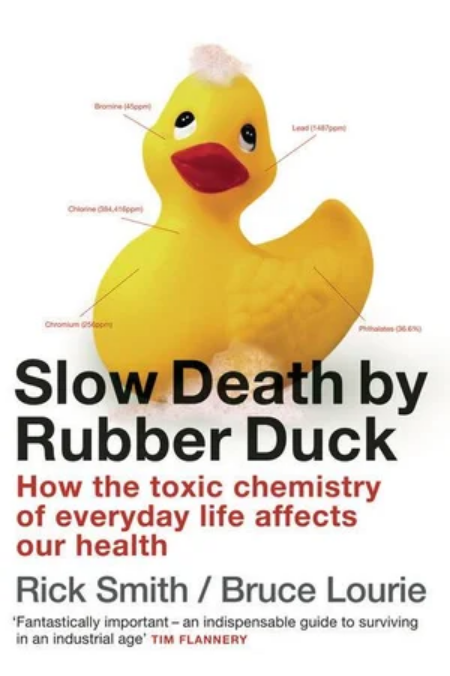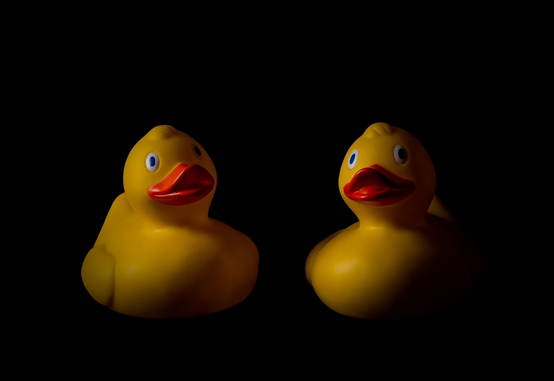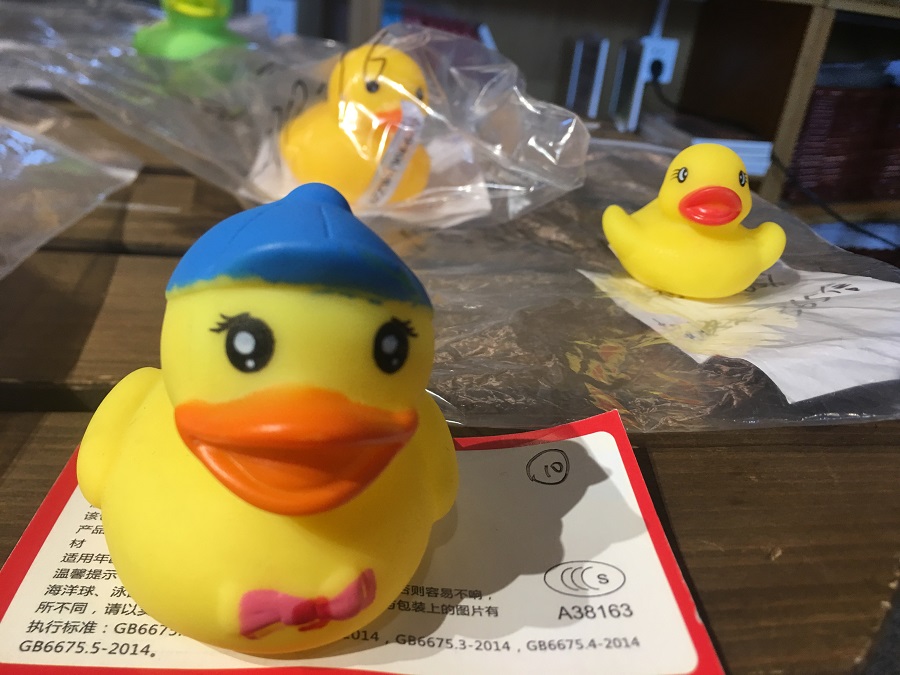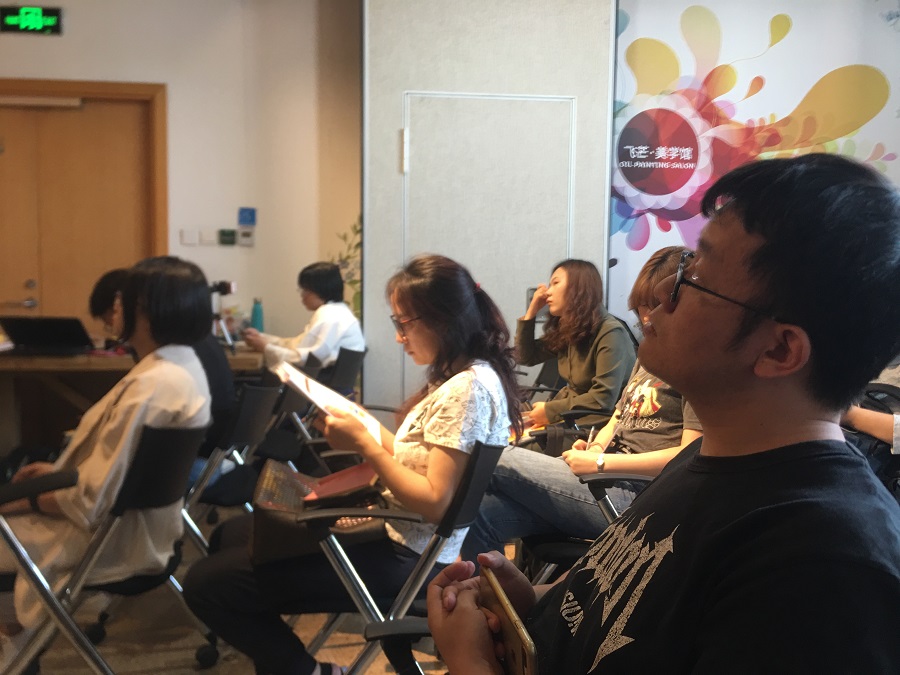The truth of the matter is that toxic chemicals are now found at low levels in countless applications, in everything from personal care products and cooking pots and pans to electronics, furniture, clothing, building materials and children's toys. They make their way into our bodies through our food, air and water.
A large and growing body of scientific research links exposure to toxic chemicals to many ailments that plague people, including several forms of cancer, reproductive problems and birth defects, respiratory illnesses such as asthma and neurodevelopmental disorders such as attention deficit hyperactivity disorder (ADHD).
At this moment in history, the image conjured up by the word "pollution" is just as properly an innocent rubber duck as it is a giant smokestack.
- From the book Slow Death by Rubber Duck
Many rubber ducks (duckies) and other toys are made from PVC which contains chemicals which may be harmful if released into the environment. Environmental and consumer groups fear that sucking or chewing the toys could cause long-term health problems, including cancer.
In the book “Slow Death By Rubber Duck: How the Toxic Chemistry of Everyday Life Affects Our Health”, leading environmentalists Rick Smith and Bruce Lourie once exposed the extent to which we are being poisoned every day of our lives, both in our homes and our workplaces. It tells the shocking story of corporate giants who manufacture these toxins, the government officials who let it happen, and the effects on people across the globe. It sheds light on everyday exposure to toxic chemicals, examines health impacts and calls for stronger regulations against toxic chemicals around the world.
In 2019, China Biodiversity Conservation and Green Development Foundation (CBCGDF) and Toxics-Free Corps jointly organized a conference on the chemical safety investigation of rubber toys on the E-commerce platforms.
On August 26, 2020, Toxic-Free Corps and CBCGDF will once again unite to release a safety report online, on the status of chemicals contained in rubber ducks on the market, revealing to the public the status of random inspections of rubber ducks for more than a year. The online press conference "Chemical Safety Investigation of E-commerce Platform Rubber Toys (II) - Taking Rubber Ducks 3C Certification Information and Plasticizer Content as an Example" will be held on August 26.
Toxic-Free Corps is an environmental social welfare organization dedicated to improving the safety status of chemicals. Beginning in October 2018, they began to pay attention to the safety of the chemicals of Evade glue class rubber duck toys sold on e-commerce platforms and found that there was a serious plasticizer: the content of phthalates exceeded the standard. Subsequently, Toxic-Free Corps fed back the results of this sampling test to e-commerce platforms, market supervision departments, and consumer rights agencies, and received positive responses. Among them, the platforms involved have taken comprehensive measures to remove the shelves, and require merchants to fill in the 3C mandatory certification information before they can resume selling related products.
In May 2019, Toxic-Free Corps and CBCGDF jointly held a press conference on rubber duckies’ chemicals, and publicly announced the result of random inspection of 300 rubber duck joys from Taobao, Pinduoduo, and JD.com. It was discovered that the webpage disclosure rate of the 3C certification information of rubber ducks sold on these three platforms was only 50%, and consumers' right to know was not fully protected. In this way, to call on the public, e-commerce platforms, and quality inspection departments to jointly supervise and promote the progress of rubber ducks in detoxification chemicals.
Starting from April 2020, Toxic-Free Corps has launched a new survey. In addition to the samples from the above three E-commerce platforms, it has also expanded to some of the e-commerce platforms specialized in maternal and child products and offline physical stores.
The investigators checked the online 3C certification information of more than 300 rubber duck toys, purchased 120 of them, and checked the physical 3C certification information. Finally, 70 of them were selected and sent to a qualified laboratory to test the content of phthalates.
Phthalates are one of the most commonly used plasticizers. After adding this substance to rubber toys, the toys will become slippery and soft, feel very good, and are more likely to be liked by children. Some children will chew on these rubber toys with their mouths when they take a bath. However, phthalates have high mobility. Once they encounter oily substances such as hot water or shower gel, they will "run" out of rubber products. Then enter the human body through the respiratory tract, digestive tract, skin, etc., and interfere with the body's normal endocrine system. Studies have shown that phthalates can promote the decline of sperm quality in men, precocious puberty in women, and increase the risk of asthma and allergies in children and adults.
Through the above investigation, Toxic-Free Corps found that, in general, some rubber duck toys sold on the market still have serious problems with excessive plasticizers, low 3C certification compliance rates, and insufficient disclosure of relevant information. Toxic-Free Corps believes that e-commerce platforms and market regulators still need to make more efforts to protect children's health rights.
The online conference will be broadcast live on CCtalk from 3:00 to 4:30 pm on August 26, 2020, Beijing time. The press conference welcomes public participation and on-site interaction and interested readers can directly scan the QR code in the picture to register for the conference.
Through this conference, you'll never look at a rubber duck the same way again!
Organizers:
Shenzhen Zero Waste (Toxic-Free Corps)
China Biodiversity Conservation and Green Development Foundation (CBCGDF)
Acknowledgement:
This event is part of the "Chemical Management Civil Network and Capacity Building" project implemented by Shenzhen Zero Waste Environmental Public Welfare Undertakings Development Center and is supported by the GEF Small Grants Programme by UNDP.

(Photo source: Internet)

(Photo credit: Pixabay)



(Photo credit: Toxic-Free Corps)






The scenes of the 2019 event (Photo credit: CBCGDF)
Reference Chinese links:
http://www.cbcgdf.org/NewsShow/4854/13588.html
https://mp.weixin.qq.com/s/FXE-MY69d7KgJn3ZNH65iQ
By / Niu Jingmei
https://www.paypal.me/CBCGDFChina
http://www.cbcgdf.org/English/ConfirmDonaTion/0.html
